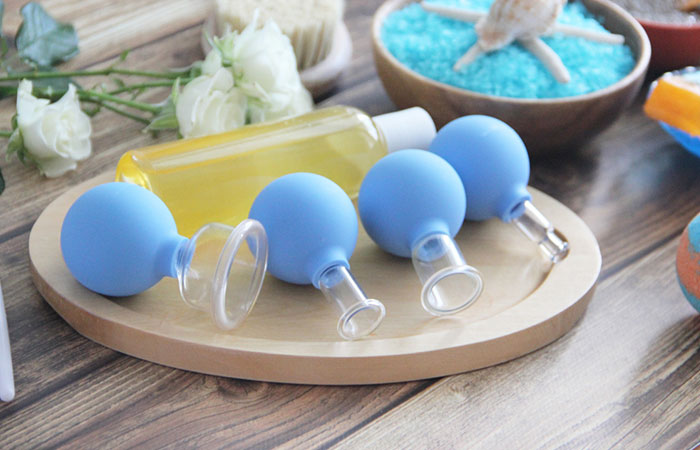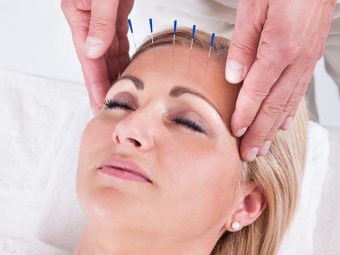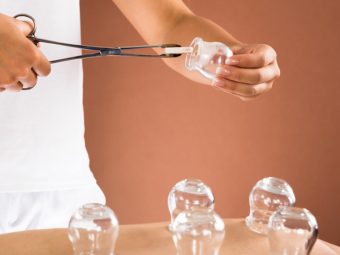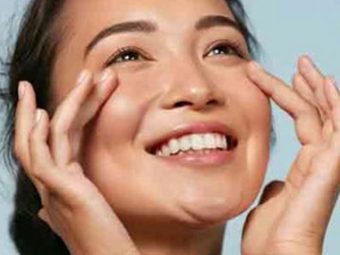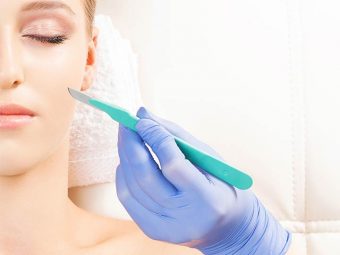Facial Cupping: Benefits, Risks, And How To Do It At Home
Try this gentle beauty treatment to tone your face and brighten your skin.

Image: Shutterstock
Facial cupping is a cosmetic method that is sweeping the internet for all the right reasons. Cupping on the head and face is done in the same way as cupping on the remainder of the body. The cups are accessible in various shapes to fit the features of your face. Unlike body cupping, which often results in cup marks or bruises, this gentle technique does not leave any marks.
Cupping may be particularly effective if you are not feeling your best. In this article, you will discover more about this beauty treatment along with its benefits and side effects. Keep scrolling!
In This Article
What Is Facial Cupping? How Is It Different From Body Cupping?
Cupping is an ancient Chinese alternative healing practice in which the therapist uses suction cups on your skin to stimulate your muscles. Like gua sha, acupressure, and facial acupuncture, this alternative medicine also helps in improving holistic health. It can be done both on your body and your face. People, especially athletes, use cupping for multiple purposes: to ease pain, reduce inflammation, relieve muscle tension, improve blood flow, and promote cell regeneration. It is also used as a deep tissue massage to promote relaxation, facial rejuvenation, and overall well-being.
The ancient Chinese believed that cupping improves the flow of positive energy or Qi (pronounced ‘chee’) throughout the body. Although this practice is linked to traditional Chinese medicine, historical evidence shows that the ancient Egyptians also used cupping therapy (1).
Both facial and body cupping follow the same principle to improve overall wellness, but the way that they are executed is different.
Facial Cupping
- It is gentler than body cupping.
- The cups that are used for facial cupping are smaller than the ones used for body cupping.
- The cups are used to pull your skin gently and rejuvenate it without leaving any marks.
- It is primarily used to improve your complexion and reduce the appearance of wrinkles and fine lines.
Body Cupping
- It is mainly used to ease aches and pains.
- It leaves behind a trail of marks that are essential for healing.
- The marks are the waste that is built up in your body. They gradually fade away as the lymphatic systemi XA network of vessels, ducts, and tissues responsible for circulating lymph (excess fluid leaked by cells) in the bloodstream. processes that waste material. This lymphatic drainage helps in detoxification and natural healing.
Georgia Perkins, a blogger, shared her experience with cupping. She writes about the process, “Typically, red, bruise-like marks are left on the skin due to blood vessels that have broken in the process. Yet despite their appearance, the process and result isn’t painful in the slightest. I actually found it incredibly relaxing! As Chris explained to me, this method brings new, fresh blood into areas where blood has become stagnant (i).”
The materials that are generally used to make the cups include:
- Silicone (mostly used for facial cupping)
- Bamboo
- Glass
- Earthenware
Want to know how facial cupping is done? Check out the next section to find out what to expect during a face cupping session.
Facial Cupping: How It Works
The process of facial cupping is super simple. A session usually lasts for half an hour. Before the therapist starts the session, they will cleanse your skin thoroughly and apply therapeutic oils on your face, neck, and chest area and gently massage it.
They use customized cups that are usually smaller than the cups used for body cupping.
- The therapist puts the cup upside down on your face.
- The reverse suction created by the cup creates a vacuum and lifts your facial tissues.
- The therapist then moves the suction cup to produce a facial massage-like effect.
 Quick Tip
Quick TipFacial cupping helps improve blood circulation. The massage rejuvenates the facial tissues as they receive more oxygen. This makes your skin feel fresh and healthy. There are multiple benefits of facial cupping. Check out the next section to find out what they are.
Benefits Of Facial Cupping
Facial cupping therapy can:
- Ease muscle tension
- Promote collageni XA protein in the body that is responsible for providing structure and support to the skin, connective tissues, and bones. production by stimulating the cells responsible for it
- Strengthen facial tissues
- Improve blood and oxygen circulation to your face
These effects
- Brighten your skin
- Reduce puffiness
- Provides an anti-aging effect as it reduces the appearance of fine lines, wrinkles, and age spots
- Tone your face and neck, especially the jawline and chin areas
It is recommended you visit a professional for facial cupping as they know the proper technique. However, you can also try it at home as part of your self-care routine using DIY facial cupping kits.
DIY Facial Cupping
Before you start facial cupping, clean your face with a mild cleanser. Then, apply jojoba oil (or any other oil of your choice) on your face. Gently massage to spread it evenly all over your face and neck area. Follow the steps given below:
- Pick up the suction cup, press it gently and place it on your face to create a vacuum.
- Once you feel the pull on your skin, glide it gently from the center of your face towards your ears.
- Always start from the center of your face and glide the cup outwards.
- Use the smaller cups in the kit to massage the eyebrow area, nose, and T-zone. Use the bigger ones to massage your forehead, jaw, and cheeks.
- Do this for 5-10 minutes.
Do facial cupping at least 2-3 times a week to reap its benefits.
But wait, the work is not done, for you need to take care of your skin after facial cupping. Check out these essential care tips in the next section.
Facial Cupping Aftercare
Your face might feel sensitive after a cupping session. Follow these tips to take proper care of your skin and avoid irritation while it heals:
- Stay hydrated by drinking an adequate amount of water daily.
- Protect your skin from the sun by using sunscreen and wearing protective clothing.
- Avoid exfoliating or shaving your face.
- Avoid taking very hot or cold showers.
- Wash your face with a mild cleanser and follow up with a nourishing moisturizer.
- Exercise regularly to promote circulation and overall health.
- Don’t rub your face repeatedly to get rid of cupping marks.
- Get enough sleep to allow your body to rest and repair itself.
- Consult with a healthcare professional for regular check-ups and screenings.
Facial cupping is considered to be a safe skin care procedure. However, you might experience some minor side effects. These potential risks and side effects are discussed below.
Potential Risks And Side Effects Of Facial Cupping
Temporary side effects of facial cupping include:
- Nausea
- Dizziness
- Lightheadedness
- Cold sweats
Avoid doing facial cupping on broken skin or if you have active breakouts or rashes on your skin.
 Quick Tip
Quick TipInfographic: How To Do Facial Cupping At Home
Facial cupping can rejuvenate the skin, promote circulation, and reduce the appearance of aging signs. You can try it at a salon, clinic, or even in the comfort of your home. If you are wondering how, let us help you out. Check the infographic given below to learn how to do facial cupping at home and learn some tips to achieve the best results.

Illustration: StyleCraze Design Team
Save the high-quality PDF version on your device now.
Download Infographic
Facial cupping is a great approach to improve your skin radiance. It improves circulation, reduces puffiness, the appearance of wrinkles, and fine lines, among other things. However, if you are a beginner, you should consult a professional as improper techniques may lead to bruises and marks. If you want to try it at home, practice cupping on your legs and arms to determine how much pressure to apply to your skin. If you have broken skin or active acne, avoid facial cupping altogether. Consult a doctor immediately if you experience any side effects or bruising.
Frequently Asked Questions
Does cupping help tighten skin?
Yes, cupping can help tighten skin. Cupping helps bring fresh red blood to the skin’s surface, which can help reshape and firm it.
Does facial cupping stretch the skin?
Yes, cupping produces a very gentle stretch. The suction effect draws blood into the fascia area beneath the skin’s surface, forming new vessels that aid tissue regeneration.
Does cupping remove cellulitei XExcess fat deposited under the skin due to an increase in the fat cells, leading to dimpled skin on the thighs, hips, and stomach. ?
According to anecdotal evidence, cupping can temporarily reduce the appearance of cellulite by increasing circulation in the area. However, research has indicated that cupping does not effectively treat cellulite.
Key Takeaways
- Cupping helps ease pain, reduce inflammation, relax muscles and improve blood flow.
- Though both body and facial cupping follow the same principle, the procedures differ.
- Facial cupping helps brighten the skin, tone your face, and reduce the appearance of aging signs.
- However, you might experience temporary side effects like nausea, dizziness, lightheadedness, and cold sweats.
Experience the rejuvenating power of massage cupping for facial renewal. Watch this video to learn about this technique and how it can improve circulation, reduce wrinkles, and give your skin a youthful glow.
Personal Experience: Source
i. What You Need to Know About Cupping Therapy
https://goodnesswithg.medium.com/what-you-need-to-know-about-cupping-therapy-2ef82888816b
Sources
- “History of cupping…”, Journal of Integrative Medicine, US National Library of Medicine.






